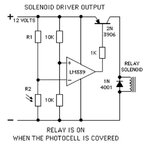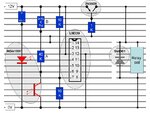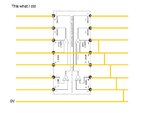Alys Bach
Newbie level 6
Hi All
I’m an electrical engineer by training but haven’t been involved much with electrical work for many years, hence a lot of catching up to do. I haven’t dealt with electronics since I was an apprentice in the 1970’s but have always had an interest in the subject and still have a good understanding (although not up to date)
I have a problem to solve that you guys may be able to help with.
I want to make a rudder position indicator for my boat. All I need to know is when the tiller arm is in one specific position (mid-ships). The wiring isn’t a problem and I think I know an easy way of doing it that I can make waterproof.
What I’d like to do is make a photo switch using an IR LED and an appropriate phototransistor/diode.
Basically the tiller arm is in a very dark location, what I was thinking of doing was attaching a reflector to the tiller arm so that when the reflector is under the LED and Photo device a relay is operated, this would preferably be an electronic relay which would allow me to pot up the unit in resin to keep out the moisture when installed.
The electronic relay will then be used to feed a lager relay coil to allow me to connect up two flashing lights and two sounders which are a considerable distance from the tiller, hence the need for an additional relay to allow for the voltage drop.
Basically has anyone built an optical switch that would be capable of performing this task and what components did you use?
I’ve looked at loads of sites but keep coming up with different answers
Any help would be appreciated and thanks in anticipation
Kind regards
Paul
I’m an electrical engineer by training but haven’t been involved much with electrical work for many years, hence a lot of catching up to do. I haven’t dealt with electronics since I was an apprentice in the 1970’s but have always had an interest in the subject and still have a good understanding (although not up to date)
I have a problem to solve that you guys may be able to help with.
I want to make a rudder position indicator for my boat. All I need to know is when the tiller arm is in one specific position (mid-ships). The wiring isn’t a problem and I think I know an easy way of doing it that I can make waterproof.
What I’d like to do is make a photo switch using an IR LED and an appropriate phototransistor/diode.
Basically the tiller arm is in a very dark location, what I was thinking of doing was attaching a reflector to the tiller arm so that when the reflector is under the LED and Photo device a relay is operated, this would preferably be an electronic relay which would allow me to pot up the unit in resin to keep out the moisture when installed.
The electronic relay will then be used to feed a lager relay coil to allow me to connect up two flashing lights and two sounders which are a considerable distance from the tiller, hence the need for an additional relay to allow for the voltage drop.
Basically has anyone built an optical switch that would be capable of performing this task and what components did you use?
I’ve looked at loads of sites but keep coming up with different answers
Any help would be appreciated and thanks in anticipation
Kind regards
Paul


